 |
|
Attack of the 50ft Whatever |
I wrote this piece a fair while ago, before I joined Random Curiosity as a writer, when the first season of Shingeki no Kyojin was on. In fact, it was purely focused on episode 01. A bit outdated? Arguably. But I think episode 01 is still the perfect showcase of the series’ use of monsters as horror, and as the first episode is the most effective at it due to its impact. So, I decided to dig up this old thing and pin it up on RandomC. Don’t laugh too hard at past-Passerby’s bad writing, folks; you’ll hurt his feelings. What, present-Passerby is bad, too? Shut it.
First things first: spoilers for episode 01 of Shingeki no Kyojin. If you intend to watch it but haven’t… well, you really should. Like, now. Go on, we’ll wait.
…Never mind, I lied. Not going to wait. Look, if they hadn’t watched it by now they’re not watching anime anyway. Moving on. We’re not actually going to start with talking about Shingeki no Kyojin, actually. We will eventually; this post is supposed to be about how the first episode of Shingeki no Kyojin effectively portrays terror, after all. Not really very high level stuff, but it’s worth talking about. Let us start with a bit about monsters in general.
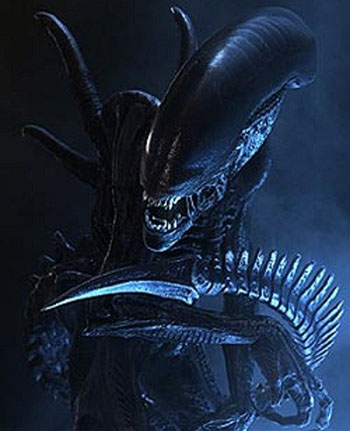 |
|
‘[Artist and designer H.R. Giger] mandated that the creature have no eyes, because he felt that it made them much more frightening if you could not tell they were looking at you.’ – Alien Evolution, Alien Quadrilogy Box Set |
Yes, I did crib both the picture and quote from Wikipedia. But the lack of face and eye contact demonstrates one of the tenants of monster design: inhumanity. Part of the reason why the titular Alien was such a successful monster was because it was just that: alien and foreign, triggering our fear of the unknown. I’m sure there’s plenty of literature on this subject, but since we’re an anime blog, let’s consult anime. I’d like to cite Kara no Kyoukai (both anime movie by UFOtable and novel), where Aozaki Touko the puppeteer lists three handy traits of terrifying monsters:
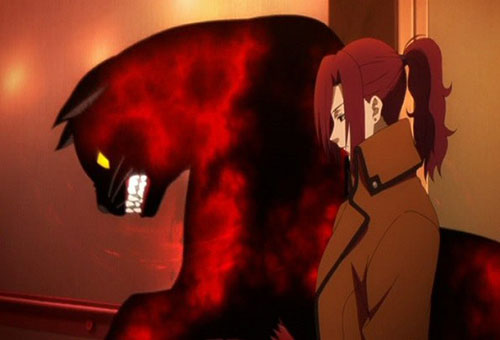 |
|
I couldn’t get a good shot of her eldritch monstrosity, so instead have a kitty. |
1. It cannot speak;
2. It cannot be identified;
3. It cannot die.
That’s all pretty simple to understand. The dehumanisation is what separates a monster from a villain. Monsters do not have values, do not have character, and cannot be empathised with. Their nonnegotiable malevolence coupled with grotesque aesthetics are designed to hit the scream switches that form the basis of many classic horror flicks.
Shingeki no Kyojin, however, is not an horror anime. It is about mankind’s struggle against an oppressive foe. Still, the first episode peddles heavily in fear, though less in the audience and more as part of the general atmosphere of its world. Remember how we were talking about monster design just now? The titular ‘kyojin’ (giants, titans, whatever) are the resident monsters. Let’s have a closer look at them.
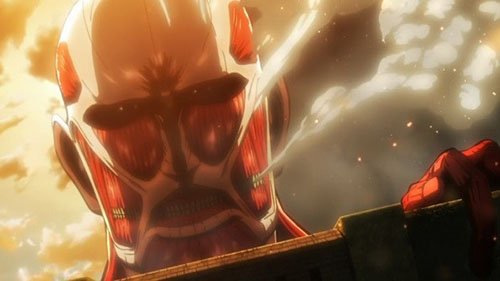 |
|
‘I did try the doorbell first.’ |
After all that fuss about monsters being inhuman, here we have a very human-looking kind of monster. Other than its completely lack of skin, of course. Shingeki no Kyojin is doing a fine balancing act here; Humans are supposed to fight and kill these beings eventually, but for now they are purely objects of terror. How do they make the kyojin monstrous? Mostly by juxtaposing them with actual humans.
Some of you may have heard of the ‘uncanny valley’, but I’ll summarise it in the most basic way. Humans tend to look for human qualities to things: consider the way Pixar can anthropomorphise anything and a colon and parenthesis makes a smiley face :). However, when an object gets too close to looking human our brains switch over to emphasising the qualities that detract from that object’s humanity. Zombies are the classic example.
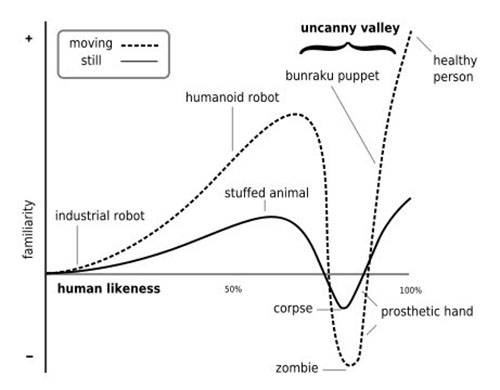 |
|
This is why there’s no movie about the teddy bear apocalypse. But there’s probably an anime. |
Frankly speaking, the skinless Colossal Titan is probably the least disturbing of all the kyojin we are shown. I mean, look at these guys from the OP.
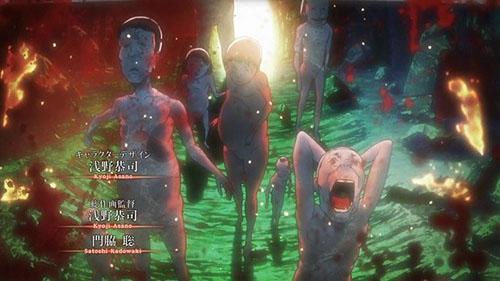 |
|
Admittedly these are more for the creep factor than anything else. |
Viewers can tell straight away that they aren’t human. Of course, that’s not enough. There’s also a great deal emphasis on their sheer strength and impossible size:
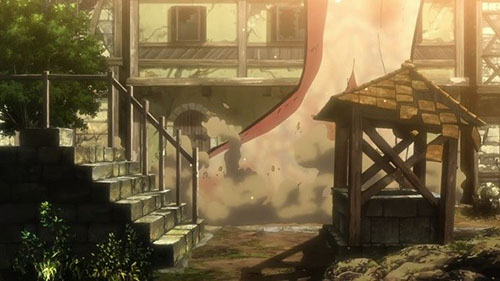 |
|
Smell-o-vision was never a good idea, anyway. |
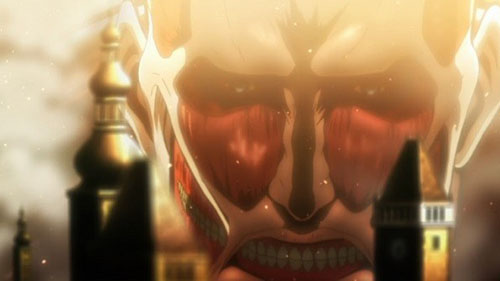 |
|
I actually had a shot of a woman being blown away by a shockwave, but the still made her look like she was doing hula oops. |
The kyojin completely dwarf the walled town. Walls are symbolic of civilisation overcoming the wild; put a wall around your settlement to keep the wolves out and now you’ve got a village. In Shingeki no Kyojin, the wild crushes the safe illusion of civilisation. Notice how all the kyojin are invariably naked and barbaric.
Oh right, and they also eat people.
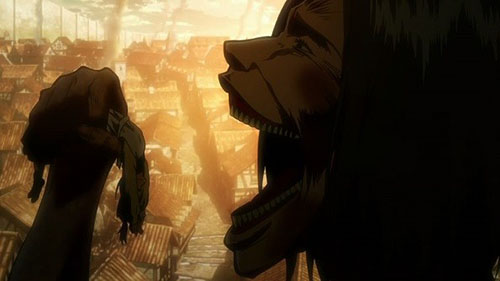 |
|
‘They’re eating her! Then they’re going to eat me!’ |
Shingeki no Kyojin slow-rolls the devouring, both evoking images of cannibalism and also triggering a very deep fear which mankind has forgotten. In the modern world, humans are the apex predators, no contest. In Shingeki no Kyojin, they sit under the kyojin. Notice the focus on teeth:
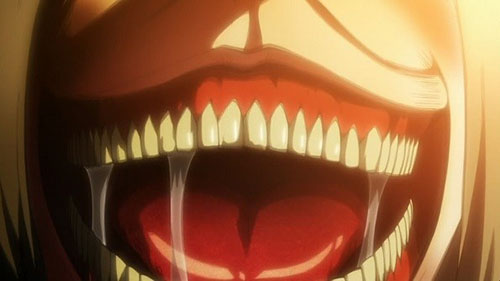 |
|
All the better to eat you with, my dear. |
The kyojin are sharks. In contrast, for the humans the emphasis is on the eyes.
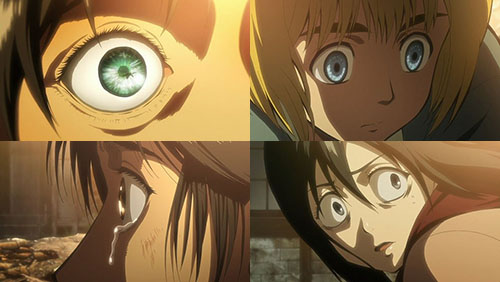 |
|
The eyes have it. (Sorry, I can’t help myself.) |
Eyes are the windows to the soul (again, designers are always playing with eyes) but all that is reflected in these ones are fear. Everything else has been subsumed by the primal fear of prey cornered by a predator. There’s a great scene of Hannes, the professional soldier dashing off determined to heroically sacrifice himself to buy some time. Even he is stopped cold, and his dead eyes face off against rows of teeth.
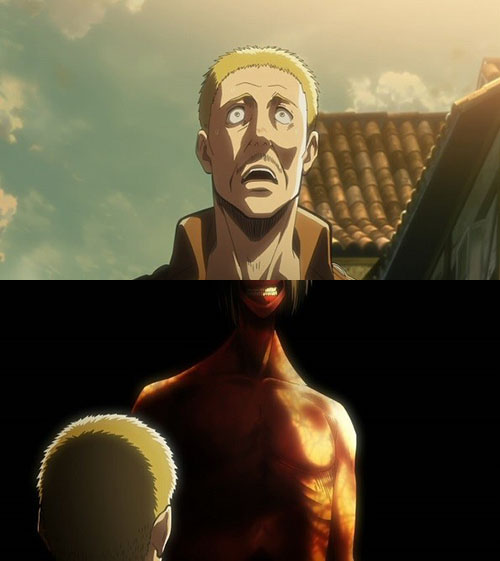 |
|
Also, good use of silence in this scene. All the dramatic choral music just die. |
For now, this is not a hotblooded action show. There is no question of morality or duty or testosterone. Fighting was not even a conceivable option. It was all flight response.
Mankind will eventually follow the premise of the story and learn more about the kyojin and tentatively start a counterattack. For episode 01, however, the kyojin are a force of nature with lots of teeth. Humans are insignificant. All developments from this point are tinted by that lens. Shingeki no Kyojin wants you to know: this is not a happy story.

Wow, this is something new on Randomc.
From my perspective, the first episode of Attack on Titan may be the best first anime episode ever. There’s a video analysis about what makes the first episode of a show or pilot episode good.
What makes the first episode so memorable is how they show the scariness of the Titans. It also introduces us, the audience, with the elements of the show and grips us with character reactions, their pure panic and terror. Character reaction is also an important part in a horror genre. Without a genuine character reaction, no matter how scary the monsters are, they won’t be scary to the audience. This is what makes horror movie, such as Alien, great.
Not just character reaction, Attack on Titan also describes the bizarreness of the Titans, like their abnormal human-like body, how light their body are despite their large sizes, and how they regurgitate eaten humans after several hours.
Well, that’s my opinion. I love this topic and I hope Randomc will have more writings about anime analysis 🙂
Oops, incorrect HTML tag for the video analysis. Here’s the link. I wish I can edit my comment….
Well, not exactly new. Besides from myself, Stilts also has his own corner here on RandomC which he used to write from back when he didn’t have more jobs than he had limbs. If you enjoy more editorial pieces, feel free to check them out. And thanks for letting us know you liked this one, if only to help us gauge audience demand.
Thank you, Passerby! Will definitely check them out. I got interested in movie (and anime) analysis just recently and I didn’t notice Stilt’s corner earlier.
Love reading it, Passerby. Stuff like this is really cool. 🙂
It’s quite an enjoyable read that captures what initially made the series so engrossing.
The Titans really do fit into that uncanny valley where your brain’s screaming that something isn’t quite right! Throw in their enormity, immortality and the fact that they only eat humans for fun, and you’ve the making of a nightmare.
Y’know, I do miss the little editiorial pieces on RandomC. They’d always provide some good food for thought.
Man, I’m so far into the manga that my view on titans has drastically changed since the beginning. I know there is a saying that you get into X for Y, but stay in X for Z. But then again, I don’t think one should ever forget the Y in this equation. The fear and the overwhelming challenge of the titans is what made people get into SnK in the first place. That should definitely stay in the viewers’ minds, even if the author himself intends to forgo it. Thanks for this piece Passerby. Reminded me of this anime’s roots.
Never really cared for SnK. Recently, I caught up with the manga out of total boredom one night and have to say that I’m now totally hooked. The mystery of the world and the nature of the titans was by far more interesting to me than the “primal terror” of the series. Honestly, in the beginning episodes, it felt like the Japanese answer to Walking Dead except without the (attempt at) meaningful character drama.